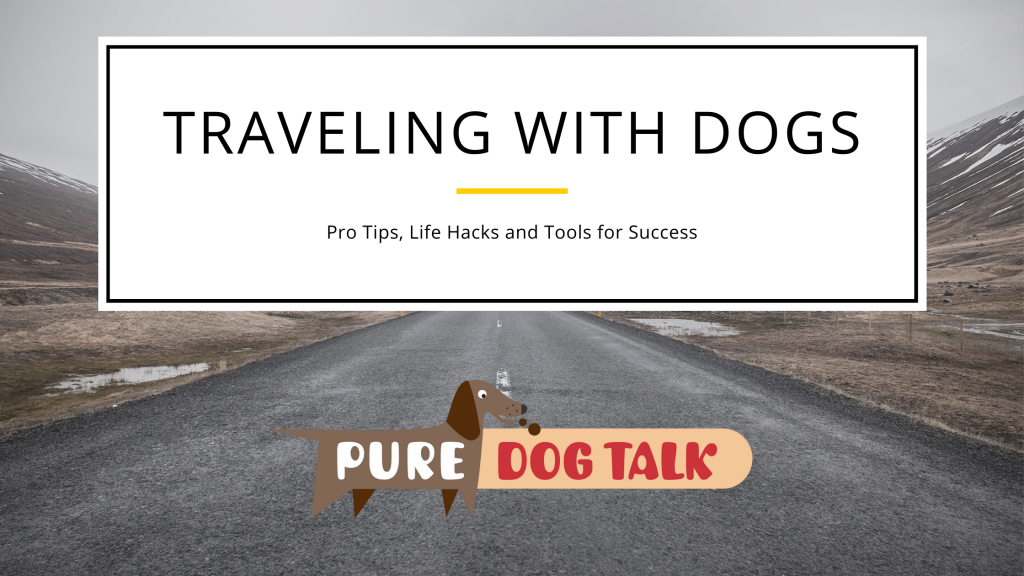494 — Traveling with dogs – Pro Tips, Life Hacks and Tools for Success

Traveling with dogs – Pro Tips, Life Hacks and Tools for Success
Forget Football and Pumpkin Spice, it’s actually National Specialty season! We’ve talked a number of times over the last few years about the *reasons* to travel to National Specialties and the JOY of traveling generally.
So now let’s talk about the practical requirements of traveling with dogs, particularly by car with your passel of pups. In a previous episode (number 113 to be exact), we talked about vehicle maintenance, water, leashes, shade, ingress/egress and more.
Today I figure we can cover a few of the more esoteric pro tips tucked away in the dark corners of my brain…. lol Proficient packing, time-saving traveling, logistics and lodging, and, most importantly, how to maintain one’s sense of humor while you’re at it.
Packing Tips from a Pro
Fitting 1000 cubic yards of “stuff” into 500 cubic yards of space is pretty much a specialty of long-time dog people. You literally never know what you’re going to need and so you bring everything except the kitchen sink. And if you travel in an rv, you have that too!
Our avatar for this trip is the Lone Human (and your plus-one if you’re lucky) and three big dogs driving the family minivan all the way across country in a long-planned adventure to the National Specialty events.
I have found that vari kennels or your preferred hard crate for in the vehicle, plus the appropriate number of folding wire crates for the grooming area is the best solution. The average minivan, ie Chrysler Town and Country, Dodge Caravan, Toyota Sienna etc can easily contain one 500 and two 400 vari kennels, three folded wire crates of the same size, two 42” expens, a grooming table and arm, tack box, grooming box, dog food tub, towel/bedding tub, water jugs and human suitcases.
The ideal vehicle packing configuration for most minivan set ups puts two four hundred crates facing out the back hatch and one 500 facing out the passenger side door. Two xpens will fit between the two four hundreds for easy access when stopping to x dogs or for the night. Three folded down wire crates, stacked, go behind the driver’s seat with the grooming table on top. Everything else is your personal version of dog show Jenga … lol
Be conscious of airflow to the crates as you pack around them, particularly if the weather is still warm and/or humid on your trip. Be sure each crate has a flat backed water bucket to clip on the inside of the crate. I like the buckets that have enclosed ends so nothing can poke the dog.
In the don’t poke the dog category, random, our best friends CAN be bungee cords. But I’ve seen too many injuries over the years to take their use lightly. Always put the poky part of the metal end of the cord *outside* the crate so a dog can’t be injured. And NEVER put yourself in a position that a bungee can snap back. It WILL put your eye out.
With that said, securing your load inside your vehicle is important. Sudden stops or, god forbid, an accident can send poorly secured items flying through the air as dangerous missiles. Use tie down points on the floor or side of the vans whenever possible. If you have to stack anything high, be sure it is light weight, like a garment bag, a grass mat, that sort of thing. Heaviest part of the load at the lowest point of the vehicle and centered as much as possible.
If your vehicle does not have a rear ac or ventilation system, be sure to buy crate fans and DOZENS of batteries. Which is, ps, a reason to include those as well as opening back wing windows, or similar, when you decide it’s time to upgrade your dog vehicle.
Speaking of which, favorite dog vehicles are a little rabbit hole we can run down here for a minute. I have personally driven everything from a Honda Civic Wagon to a 40’ diesel pusher to dog shows. Including a pickup with topper, minivan, full sized cargo van, Mercedes Sprinter van, class C cab over RV, 35’ gas class A RV and what was fondly referred to as the “Pregnant Cadillac” — a 1973 GMC motorhome with front wheel drive built on a Toronado chassis… they were a cult collector’s item for a while and look for all the world like the Scooby Mobile.
Each and every one has its pluses and minuses. Buy recent model, low mileage used whenever possible. Trade the new car smell for the $10-15,000 it’ll cost. Put that into upgrades that are specific to what we dog people need, like a roof vent/fan that can be installed in pretty much any vehicle. When shopping, take a measuring tape. Measure your crates and then measure the cargo space. Front to back, side to side, floor to roof. Don’t forget to take the width between wheel wells and height at door openings into consideration.
As much and as long as I fought the curse of the minivan, I have to tell you, the all-wheel drive Toyota Sienna I have now may be my favorite rig of all time. Plenty of space to pack as described above, right around 25 mpg consistently, comfortable seats for the long haul, low maintenance, all weather, most terrain (like, don’t take it mudding fgs) and plenty of power for mountain passes, even loaded to the gills.
Tips to save you time, money and good health
When you have a 5,000 mile round trip and a limited amount of vacation, every minute on and off the road needs to be utilized efficiently.
Routine vehicle maintenance like timely oil changes, regular tire rotations and front-end alignments will help avoid time-sucking emergencies. Driving within reasonable speed limits, using basic traffic safety measures and assuming “they’re all trying to kill you” ie defensive driving, will help reduce the risk of traffic accidents.
It helps to have a vigilant guardian angel, too.
With that said, where we can most feasibly keep our time off the road to a minimum is by coordinating people potty, dog potty, food and fuel all at the same time whenever possible. Four hours is roughly 300 miles at 75 mph (a normal speed limit on the interstate). That coincidentally is about how much fuel most tanks hold.
Fuel costs can vary *dramatically* just by crossing into a different state. I can tell you the cheapest gas prices on Interstate 80 between Oregon and anywhere every time! lol For example, always fill your tank in Oregon before driving in to California or Washington. Also, Laramie, WY has the lowest prices in the state. And, whatever you do, avoid like the plague gassing up at the Cabelas in Sydney, NE (although they have great dogs runs and grass and even a campground. Just don’t buy fuel there!) Fred Meyer, Safeway and other similar chains often have fuel discounts with their loyalty cards. Use them whenever you can! Saving .10 – to as much as .50 per gallon on a trip that will consume well over 200 gallons of gas adds up to significant cost saving. Use it to buy your dogs new chew bones for the trip.
I like breaking my day into two (although I have done three) four-hour chunks, sort of like an eight-hour day of work. Filling up the car tank and your tummy, emptying the doggies and letting them stretch their legs should all take 30-45 minutes. If you have to push for more mileage in a day, plan your end points ahead (I LOVE mapquest for this!) and build in your breaks. Old broken driver tip… if you have a bad back, stop more frequently for shorter durations so you can change position, walk around, keep the blood moving.
If you have two people to drive and can safely switch off for longer duration between overnights, happy day. If not, safety parameters drop drastically for most drivers after 12 hours behind the wheel, at which point I strongly recommend stopping for a rest break. There is a reason it is mandated for long-haul truckers.
Eating healthy food on a huge trip can be another seemingly overwhelming challenge. Adding even a small soft sided cooler to your packing can make bringing snacks like carrots, grapes, nuts, cheese and crackers a viable option. This enables you to eat a power breakfast (I highly recommend protein!) before driving, have snacks to help keep you awake and then enjoy a decent sit-down dinner once you have dogs taken care of at the end of the day’s drive. This also cuts out one of the midday tasks when stopped and gives you more time to exercise the dogs.
Logistics and lodging
Whether your concerns are sanitation related, safety related or budget related, lodging takes up a lot of our brain cells when we travel. If you’re super lucky, you have a huge network of friends, relatives and casual dog acquaintances who’d be happy to put you and your pack up for a night. Most of us aren’t that lucky!
So that means managing travel times, pet friendly accommodations, COVID protocols that often vary by state, costs and more. Once upon a time, I put some 50-60,000 miles a YEAR on my vehicles. I’ve stayed in every type of hotel, motel, notel, campground, briar patch, you name it, that you can think of. In nearly every instance I was a single woman traveling alone. Granted, I had big dogs, but they don’t go in, say, the lobby when you check in or the restroom at the rest area. Like that. Very, very rarely did I encounter difficulty that caused me to fear for my safety. The one time that has stayed with me was a relatively sketchy hotel somewhere in the boontillies of nowhere’sville. I checked in and ran for the bathroom. Threw my key down and apparently didn’t get the room door shut. Because just as I’m coming out of the bathroom, the rando creepy dude from behind me at checkout pushes it open and walks right on in. Now, I happen to be relatively cranky at this point … I’m pretty sure a sailor blushed three states away as I read him the riot act and he scurried back out the door.
I called the desk, got my very large and equally cranky wirehair out of the vehicle to be my bed buddy and used the chain lock. But again, that’s one incident in 25 years and quite literally a million miles driven.
With all of that said, we all have our favorite hotel chains etc. In the last year or so I’ve become very fond of the campground set ups that offer Kamping Kabin type rooms. Basically self-contained little rooms, preferably with their own restrooms. They don’t cost more than a decent hotel, fewer people to encounter, normally pet friendly, often with large dog runs or play areas. Aside from that, I am a fan of Best Western and LaQuinta. It’s a few bucks more than anything with a number in the name, but very rarely are the surroundings questionable, the beds are generally good, the water is hot and they usually give you some nice powdered eggs and sausage for your protein packed breakfast…. Lol As with anything, VERIFY pet friendly status when booking any room.
Tis better to laugh than cry
NEVER will this be more true than on a cross-country voyage with dogs. Guaranteed. You WILL forget something (hopefully it won’t be the dog). There WILL be some sort of crisis of timing or traffic or weather. Someone, somewhere will almost certainly cut in front of you in some kind of line. You WILL get lost. A dog WILL, absolutely, puke or have a bad potty outburst in rush hour traffic on a high-rise bridge in a major metropolitan area. (PS I always plan carefully to NEVER arrive at any metropolitan area at either of the major rush hours if I can do ANYthing to avoid it! PPS Be sure than extra rolls of paper towels, cleaning supplies and fresh bedding are on your checklist!)
Focus on the positive. Sing along with bad country music turned up loud. Laugh at the lunacy. If you spend two and half weeks mad about every single thing that goes wrong, you will miss the beauty, the excitement, the wonder and the joy that your trip should be all about. Build in an hour or two at some cool national park you’ve never seen and walk the dogs down those ancient paths. Take in some history or some natural splendor and let your anxiety and frustration drain away.
If you are lucky enough to have a sidekick, bring silly trivia card games, tell jokes and tall tales, take turns napping in the passenger seat while the other person drives. One of our favorite games used to be naming our dream BIS line ups, arguing about which dog should go BIS. I often write in my head while I drive, other folks use audio books to pass the time. Or make a driving play list on your mobile device. Or, best plan ever, binge listen to Pure Dog Talk! This is what we were made for!
The bottom line is YOU are in charge of YOUR attitude. Your guardian angel may be in charge of everything else. But if something slips through the cracks, how you respond makes all the difference.
Bon voyage. And bon chance.
KNOWLEDGE IS POWER — FRANCIS BACON
When you become a patron of Pure Dog Talk you’ll tap into an exclusive community of experts to help you and your dog be blue-ribbon best at whatever you do with your purebred dog! Your support helps keep the MP3's rolling at Pure Dog Talk!
As a supporter, you’ll immediately gain access to the weekly Pure Pep Talk SMS, Pure Pep Talk private Facebook group, and priority emails. Patrons can choose to level up to the After Dark Zoom and a Patrons Digital Badge for their website— even a private counseling session with Laura on any topic.

DON'T MISS AN EPISODE!!












